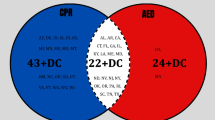Abstract
Public access defibrillation (PAD) in the adult population is thought to be both efficacious and cost-effective. Similar programs aimed at children and adolescents have not been evaluated for their cost-effectiveness. This study evaluates the potential cost-effectiveness of implementing Project ADAM, a program targeting children and adolescents in high schools in the Milwaukee Public School System. Project ADAM provides education about cardiopulmonary resuscitation (CPR) and the warning signs of sudden cardiac death (SCD) and training in the use and placement of automated external defibrillators (AEDs) in high schools. We developed decision analysis models to evaluate the cost-effectiveness of the decision to implement Project ADAM in public high schools in Milwaukee. We examined clinical model and public policy applications. Data on costs included estimates of hospital-based charges derived from a pediatric medical center where a series of patients were treated for SCD, educational programming, and the direct costs of one AED and training for 15 personnel per school. We performed sensitivity analyses to assess the variation in outputs with respect to changes to input data. The main outcome measures were Life years saved and incremental cost-effectiveness ratios. At an arbitrary societal willingness to pay $100,000 per life year saved, the policy to implement Project ADAM in schools is a cost-effective strategy at a threshold of approximately 5 patients over 5 years for the clinical model and approximately 8 patients over 5 years for the public policy model. Implementation of Project ADAM in high schools in the United States is potentially associated with an incremental cost-effectiveness ratio that is favorable.





Similar content being viewed by others
References
S Al-Khatib E Pritchett (1999) ArticleTitleClinical features of WPW syndrome. Am Heart J 138 403–413
Becker A (1988) Congenital malformations of the coronary arteries. In: Anderson RH, Neches WH, Park SC, Zuberbuhler JR (eds) Perspectives in Pediatric Cardiology. Future, Mount Kisco, NY
S Berger A Dhala D Friedberg (1999) ArticleTitleSudden cardiac death in infants, children, and adolescents. Pediatr Cardiol 46 221–234
JT Cassidy (2001) Systemic lupus erythematosus, juvenile dermatomyositis, scleroderma, and vasculitis. S Ruddy ED Harris SuffixJr CB Sledge (Eds) Kelly’s Textbook of Rheumatology EditionNumber6 Saunders Philadelphia
W Friedman N Silverman (2001) Congenital heart disease in infancy and childhood. E Braunwald (Eds) Heart Disease: A Textbook of Cardiovascular Medicine EditionNumber6 Saunders Philadelphia
J Goodwin (1997) ArticleTitleSudden cardiac death in the young. Br Med J 314 843
P Groenveld J Kwong Y Liu et al. (2001) ArticleTitleCost-effectiveness of automated external defibrillators on airlines. J Am Med Assoc 286 1482–1489
K Kern (1998) ArticleTitlePublic access defibrillation: a review. Heart 80 402–404
J Marenco P Wang M Link M Homoud N Estes SuffixIII (2001) ArticleTitleImproving survival from sudden cardiac arrest: the role of the automated external defibrillator. J Am Med Assoc 285 1193–1200
Mueller FO, Cantu RC (2001) Eighteenth annual report fall of 1982–spring of 2000. University of North Carolina at Chapel Hill, National Center for Catastrophic Sport Injury Research, Chapel Hill, NC [Revised July 19, 2001]. Available at http://www.unc.edu/depts/nccsi/AllSport.htm (accessed November 28, 2001)
National Center for Education Statistics (1996) Youth indicators 1996: trends in the well-being of American youth. Indicator 47. Athletics and exercise. U.S. Department of Education, Washington, DC [Revised September 1996]. Available at http://nces.ed.gov/pubs/yi/y9647a.html (accessed November 28, 2001)
National Federation of State High School Athletic Associations (2001) Athletics participation survey totals. Available at http://www.nfhs.org/part_survey99-00.htm. (accessed November 29, 200 l)
G Nichol A Hallstron J Ornato et al. (1998) ArticleTitlePotential cost-effectiveness of public access defibrillation in the United States. Circulation 97 1315–1320
L Rubin (1997) ArticleTitleCurrent concepts: primary pulmonary hypertension. N Engl J Med 336 111–117 Occurrence Handle10.1056/NEJM199701093360207 Occurrence Handle1:STN:280:ByiC3s%2Fgs1w%3D Occurrence Handle8988890
RC Sachdeva SB Cantor LS Jefferson JR Beck (1997) ArticleTitleHealth policy implications of a cost-effectiveness analysis for admitting patients to the pediatric intensive care unit. Dis Mgt Clin Outcomes 1 81–86
K Schwartz (2000) ArticleTitleMyocardial diseases. Circulation 102 IssueIDsuppl IV34–IV39
I Stiell G Wells III Field B et al. (1999) ArticleTitleImproved out-of-hospital cardiac arrest survival through the inexpensive optimization of an existing defibrillation program: OPALS study phase II. J Am Med Assoc 281 1175–1181
U.S. Census Bureau (2000) U.S. Department of Commerce, Washington, DC. Available at http://www.census.gov/population/estimates/nation/intfilel-l.txt (accessed November 30, 2000)
G Vincent (2000) ArticleTitleLong QT syndrome. Cardiol Clin 18 309–325
M Weisfeldt R Kerber R McGoldrick et al. (1995) ArticleTitlePublic access defibrillation. A statement for healthcare professionals from the American Heart Association Task Force on Automatic External Defibrillation. Circulation 92 2740–2747
M Weisfeldt R Kerber R McGoldrick et al. (1996) ArticleTitleAmerican Heart Association Taskforce on Automatic External Defibrillation. Statement on public access defibrillation. Resuscitation 32 125–126
R White B Asplin T Bugliosi D Hankins (1996) ArticleTitleHigh discharge survival rate after out-of-hospital ventricular fibrillation with rapid defibrillation by police and paramedics. Ann Emerg Med 28 480–485
K Young J Seidel (1999) ArticleTitlePediatric cardiopulmonary resuscitation: a collective review. Ann Emerg Med 33 195–205
Acknowledgments
We thank the following for their assistance in the development of the models used in this cost-effectiveness analysis: Karen Bauer (Children’s Hospital of Wisconsin), Edward McMilin (Milwaukee Public School System), Cecelia Needham (Medical College of Wisconsin), Andrew Pelech (Medical College of Wisconsin), and Susan Wendt (Children’s Health System). In addition, we acknowledge the following individuals for their assistance and support in the development and implementation of Project ADAM: David Ellis, Robert Kliegman (Medical College of Wisconsin), Joe and Patty Lemel, David Petasnick (Children’s Hospital of Wisconsin), and Becki Jo Hirschy (Children’s Hospital of Wisconsin).
Author information
Authors and Affiliations
Corresponding author
Rights and permissions
About this article
Cite this article
Berger, S., Whitstone, B.N., Frisbee, S.J. et al. Cost-Effectiveness of Project ADAM. Pediatr Cardiol 25, 660–667 (2004). https://doi.org/10.1007/s00246-003-0668-z
Published:
Issue Date:
DOI: https://doi.org/10.1007/s00246-003-0668-z




